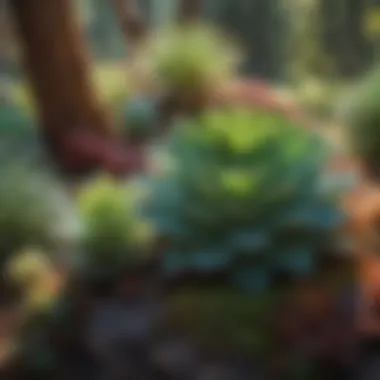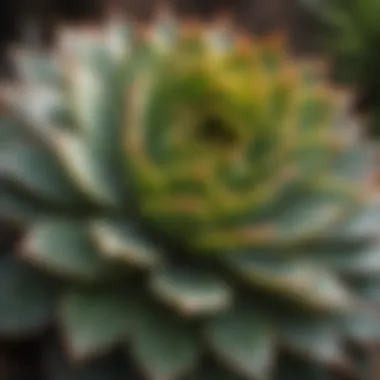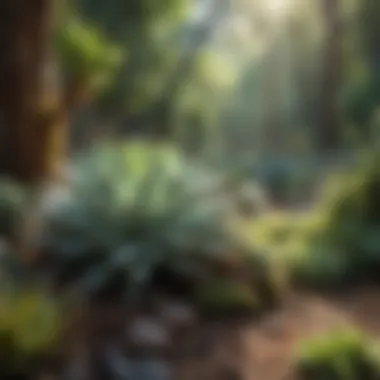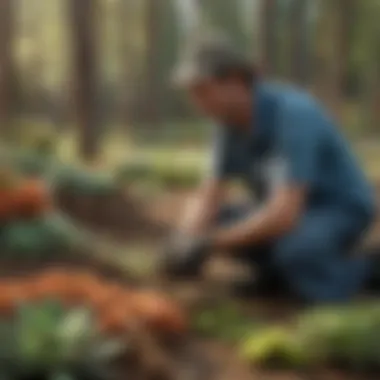Cultivating Succulents in Bend, Oregon: A Guide


Intro
Succulents have gained significant popularity in recent years, both as decorative plants and as symbols of resilience in the face of challenging environmental conditions. In Bend, Oregon, a region characterized by its unique climate, cultivating succulents presents both opportunities and challenges. This article delves into the specific cultivation techniques and care practices required in this locality, addressing various aspects from suitable species to local engagement in horticulture.
The cultivation of succulents in Bend, Oregon, is particularly intriguing due to the region's high desert climate. With its intermittent rainfall and fluctuating temperatures, understanding the needs of these plants becomes essential for success. This guide aims to provide a thorough exploration of succulent care, highlighting key considerations such as irrigation, soil quality, pest control, and the selection of appropriate varieties. By systematically covering each topic, we aim to equip both novice and experienced gardeners with the knowledge required to thrive in growing succulents in this specific region.
Understanding Succulents
Succulents are a diverse group of plants that have adapted to conserve water in arid environments. Their unique features, such as thick, fleshy leaves and stems, enable them to store moisture. This ability makes succulents ideal candidates for the high desert landscape of Bend.
Key Characteristics of Succulents
- Water Storage: Succulents have developed tissues that store water, which is vital for surviving prolonged dry periods.
- Diverse Varieties: There are thousands of species of succulents, ranging in size, shape, and color, offering many options for gardeners.
- Low Maintenance: Generally, succulents require minimal care, making them suitable for both beginners and busy individuals.
Growing Conditions in Bend
To successfully cultivate succulents in Bend, it is essential to understand the local environmental conditions. The climate is often classified as semi-arid, with considerable sunlight and dry air.
Climate Considerations
- Temperature Variability: Due to high summer temperatures and cold winter spells, gardeners must choose species that can handle these fluctuations.
- Soil Quality: The native soil in Bend can be rocky and draining. This characteristic can be an advantage for succulents, which prefer well-draining soil.
Watering Practices
Proper irrigation is crucial. Overwatering is a common mistake among succulent growers.
- Frequency: Water succulents only when the soil is completely dry, typically every two to three weeks in summer.
- Irrigation Method: Using a deep soak method can be effective. This means watering thoroughly and allowing excess to drain away.
“Understanding the specific needs of your plants can transform your gardening experience.”
Selecting Appropriate Varieties
Choosing the right succulent species is foundational to successful cultivation. Some species are better suited for the Bend climate than others.
Recommended Varieties
- Echeveria: Known for its rosette shape and vibrant colors, it is both beautiful and resilient.
- Sedum: This quick-growing succulent is great for beginners and can withstand diverse conditions.
- Agave: Excellent for its architectural form; however, it requires more space.
Community and Resources
Engagement in local gardening communities can provide invaluable support for succulent care. Local nurseries, horticultural clubs, and extension programs often offer workshops and resources tailored to Bend’s climate. Connecting with fellow gardeners can enhance the experience and expand knowledge.
Local Resources
- Local Nurseries: Places like The Plant Room or Bend Farmers Market offer native varieties and expert advice.
- Online Communities: Platforms like Reddit have dedicated groups where gardeners share tips and updates about their experiences growing succulents.
By understanding the unique conditions present in Bend, Oregon, and the specific needs of succulents, gardeners can create flourishing ecosystems that reflect both the beauty and adaptability of these plants. As we move forward in our exploration, attention to detail in every aspect of succulent care will ensure thriving plants capable of enduring the challenges posed by their environment.
Prolusion to Succulents
Succulents are plants that have adapted to the harsh conditions of their environments, characterized by thickened, fleshy parts that store water. Understanding succulents is crucial for cultivating them, particularly in a region like Bend, Oregon, where the climate and soil conditions pose unique challenges and opportunities for growth.
This segment provides an overview of what succulents are and sets the foundation for a deeper exploration into their characteristics and adaptations. The benefits of growing succulents are multifaceted. They require less water compared to many other plants, making them suitable for arid regions. Moreover, their striking appearances can enhance any landscape.
By grasping the definition and characteristics of succulents, horticulturists in Bend can better select the right varieties for their gardens. This knowledge also underscores the importance of cultivating resilient ecosystems that can withstand local environmental stresses.
Definition and Characteristics
Succulents, by definition, are plants that possess significant water-storage capabilities in their leaves, stems, or roots. This ability enables them to thrive in arid and semi-arid climates. Common examples include Echeveria, Agave, and Sedum. These plants come in various shapes, sizes, and colors, which makes them versatile for landscaping.
The distinguishing features of succulents include:


- Thickened leaves or stems: These store moisture, allowing the plant to survive prolonged dry periods.
- Waxy coating: This reduces water loss through transpiration, preserving moisture within the plant.
- Drought resistance: Their ability to withstand dry conditions makes them low-maintenance options for many gardeners.
Understanding these characteristics can help Bend residents choose which succulents to cultivate, ensuring they select varieties that will thrive in local ecosystems.
Evolution and Adaptation
Succulents have evolved to adapt to environments where water is scarce. This adaptive evolution can be traced back millions of years to the deserts where many of these species originated. Their ability to store water has resulted in various morphological adaptations that enhance survival, including deeper root systems.
One key aspect of succulent adaptation is CAM (Crassulacean Acid Metabolism) photosynthesis. This method allows succulents to open their stomata at night and conserve moisture by minimizing water loss during the day.
In Bend, understanding these evolutionary traits becomes vital. The local climate features dry summers and cold winters, which means selecting succulents that can endure these conditions is crucial. Recognizing how succulents have adapted over time highlights their resilience and provides insights into effective cultivation techniques.
Bend, Oregon: Climate Overview
Understanding the climate of Bend, Oregon is essential for successful succulent cultivation. The unique climate not only shapes the environmental conditions but also influences the growth patterns and health of these resilient plants. Given Bend's semi-arid territory, it is characterized by distinct temperature variations and patterns of precipitation that merit detailed exploration.
Geographical Features
Bend is located in central Oregon, surrounded by a diverse natural landscape. The high desert environment brings both challenges and advantages for successful succulent growth.
- Elevation: At approximately 3,600 feet above sea level, Bend’s altitude can lead to cooler nighttime temperatures, which is crucial for certain succulent varieties that thrive in variable conditions.
- Topography: The presence of nearby mountains influences local weather patterns, leading to diverse microclimates. Higher elevations tend to retain more moisture, while lower areas may experience arid conditions, which can impact soil moisture levels.
- Geological Composition: The area is rich in volcanic soil which can be beneficial for succulents. The porous nature of volcanic soil promotes drainage, critical for preventing root rot in succulents.
In summary, the geographical features of Bend set the stage for understanding succulent cultivation. The topography and soil characteristics provide a distinctive environment that necessitates specific strategies for care and maintenance.
Temperature and Precipitation Patterns
Bend’s temperature and precipitation patterns fluctuate significantly throughout the year. This variation plays a significant role when selecting succulent varieties.
- Temperature: Bend experiences warm summers and cold winters. Daytime summer temperatures can soar above 80°F, while winter nights can plunge below freezing. Succulents that are particularly cold-hardy must be selected to survive these extremes. Understanding local frost dates is also important for scheduling planting and protecting succulents from unexpected cold snaps.
- Precipitation: With an average annual precipitation of around 12 inches, water availability is sparse, particularly during the growing season. Most of the rainfall occurs in the winter months, necessitating careful water management during the dry summer. A deep understanding of these patterns allows growers to implement efficient irrigation practices to ensure plants receive adequate moisture without overwatering.p>
"The climate of Bend, Oregon is critical when considering the successful establishment and sustained growth of succulents. Knowing local patterns directly affects plant selection and care practices."
Selecting Succulent Varieties for Bend
Selecting the right succulent varieties for Bend, Oregon, is crucial for successful cultivation. The unique climate in Bend presents both opportunities and challenges. Understanding these elements can help gardeners make informed decisions about which succulents to grow. Choosing resilient varieties ensures better adaptability, longevity, and overall health of the plants.
Cold-Hardy Succulents
When considering cold-hardy succulents, it is essential to prioritize species that can withstand the winter temperatures specific to Bend. Sempervivum and Sedum are prime examples. These types are known for their hardiness and ability to thrive even in colder months. They exhibit remarkable attributes, such as drought resistance and minimal care requirements.
Cold-hardy succulents can endure freezing temperatures, making them ideal for outdoor gardens that experience frost. They typically store moisture in their leaves, which aids in their survival during dry periods. To enhance their longevity, these plants should be situated in well-draining soil. Additionally, placing them in locations that receive ample sunlight will help in their growth and resilience.
Some notable cold-hardy succulents to consider include:
- Hens and Chicks (Sempervivum tectorum): Adaptable and form beautiful rosettes.
- Stonecrop (Sedum spectabile): These have stunning blooms that attract pollinators.
- Agave parryi: Known for its striking rosettes and robustness.
Native Succulent Species
Native succulent species bring a distinct advantage to gardeners in Bend. These plants are naturally adapted to the local climate and soil conditions, which often leads to lower maintenance efforts. Understanding the local ecosystem allows for more sustainable gardening practices.
Oregon’s native sedums are particularly noteworthy. They require less watering due to their developed root systems adapted for arid environments. Furthermore, they contribute to the local biodiversity, offering habitats for various wildlife. By choosing native succulents, gardeners can also promote ecological balance in their landscapes.
Some examples of native succulent species that thrive in Bend include:
- Sedum oregonense: Features attractive yellow flowers and thrives in well-drained soil.
- Echeveria elegans: Known for its beautiful rosettes and soft hues, offering aesthetic appeal.
- Delosperma cooperi: This low-growing plant produces vibrant blooms and is drought-resistant.
By focusing on these aspects of selection, gardeners in Bend can cultivate thriving collections of succulents that are not only beautiful but also well-suited to the region’s climatic realities.
Cultivation Techniques
Understanding cultivation techniques for succulents in Bend, Oregon is essential for achieving optimal growth and health of these resilient plants. This section delves into the intricate balance of soil composition, watering requirements, and light and temperature needs, all of which are critical for successful succulent care. The right combination of these elements not only ensures that the plants thrive but also helps mitigate the challenges posed by Bend's unique climate and soil conditions.


Soil Composition and Amendments
The foundation of any healthy plant growth begins with soil. For succulents in Bend, using the right soil composition can enhance drainage, which is crucial for these plants that are sensitive to overwatering. A well-draining mix typically contains a blend of potting soil, coarse sand, and perlite or pumice. This combination allows excess moisture to escape while retaining some moisture needed for the succulents' root systems.
Key Amendments to Consider:
- Perlite: Improves aeration and drainage.
- Sand: Adds structure and facilitates drainage.
- Compost: Provides organic nutrients while maintaining the necessary drainage.
When preparing the soil, it’s important to test the pH, ideally aiming for a slightly acidic to neutral range, between 6.0 and 7.0. This ensures that the nutrients remain readily available to the plants, fostering their growth.
Watering Requirements
Watering succulents in Bend can be tricky. Given the area's arid climate, it is vital to develop a sound watering strategy. Overwatering is one of the most common mistakes among succulent growers, leading to root rot and other issues.
Best Practices for Watering:
- Allow Soil to Dry: Wait until the top two inches of soil are completely dry before watering again.
- Deep Watering: When you do water, ensure that the entire root zone is hydrated, allowing water to escape from the drainage holes.
- Seasonal Adjustments: Reduce watering during winter months when succulents enter a dormancy phase.
A practical approach is to use a moisture meter. It can help in determining when the plants need water, particularly during hot summer months.
Light and Temperature Needs
Measuring light and temperature is another key factor in successfully growing succulents in Bend. These plants prefer bright, indirect sunlight to direct scorching rays, which can damage their leaves.
Recommendations for Optimal Light Exposure:
- Location: Place succulents near windows that receive filtered light, such as those covered by sheer curtains.
- Rotate: Occasionally rotating the pots will ensure even light exposure and prevent uneven growth.
In regards to temperature, most succulents thrive in a range between 65°F to 80°F. During the colder months, temperatures can drop significantly, so bringing potted succulents indoors or using protective covers for garden plants is advised to avoid frost damage.
In summary, successful cultivation of succulents in Bend hinges on a nuanced understanding of soil composition, watering needs, and light parameters. This knowledge allows the grower to create optimal growing conditions, ensuring that these plants flourish in their unique climatic context.
Common Pests and Diseases
Understanding common pests and diseases is crucial for maintaining the health of succulents in Bend, Oregon. These resilient plants can still be vulnerable to various challenges that may hinder their growth, so identifying and managing these issues effectively enhances their longevity and overall aesthetic appeal. Awareness of potential problems allows for proactive measures, thereby fostering a thriving succulent environment.
Identifying Pest Issues
Pests can target succulents in many ways. The most common pests for these plants include aphids, mealybugs, and spider mites. Each of these species can cause significant stress on succulents, leading to wilting or discolored leaves.
- Aphids are small, sap-sucking insects that may be green or black. They often cluster on new growth or the undersides of leaves.
- Mealybugs appear as white, cotton-like masses on the plant. They tend to reside in leaf joints and may contribute to mold growth due to their honeydew excretion.
- Spider mites are barely visible to the naked eye but can cause yellowing leaves and fine webbing.
Additionally, observing wilting, spots, or any unusual growth patterns in plants can signal underlying pest issues. Regular inspections of both leaves and soil should be part of routine succulent care.
Preventative Measures
Taking preventative measures can significantly reduce the likelihood of pest infestations. Here are strategies that can assist in safeguarding succulents:
- Regular Monitoring: Frequent checks for pests can catch issues early. Monitor growth and overall plant health regularly.
- Healthy Environment: Proper light and air circulation help keep pests at bay. Avoid overcrowding plants.
- Clean Plants: Wipe leaves gently with a damp cloth to remove dust or any potential eggs.
- Natural Remedies: Solutions like neem oil or insecticidal soap can deter pests. These are less harmful to plants and the environment than harsh chemicals.
By employing these strategies, succulent enthusiasts can create a healthier and more sustainable growing environment. Maintaining vigilance and preparing for potential pest issues is essential for advancing their cultivation skills.
"Early detection and treatment of pest problems can lead to successful management and a flourishing succulent garden."
This approach not only ensures the vitality of individual plants but also supports local ecosystems by reducing chemical reliance.
Sustainable Practices in Succulent Care
Sustainable practices are critical when cultivating succulents in Bend, Oregon. The unique climate and soil conditions of the region require thoughtful approaches to ensure the health of the ecosystem while promoting resilient plant growth. Practicing sustainability not only optimizes resource use but also mitigates the negative impacts of gardening on the environment. By adopting sustainable methods, cultivators can decrease water consumption and reduce reliance on chemical inputs, which often harm local soils and waterways.
Consideration for local biodiversity, particularly in the context of native succulent species, enhances resilience. These plants have evolved to withstand the local conditions, thereby supporting a balanced ecosystem. Moreover, sustainable practices can lead to healthier plants, less pest and disease incidence, and a richer gardening experience overall.


Water Conservation Techniques
Water conservation is essential in arid areas like Bend, where precipitation is limited. Succulents naturally require less water, but smart irrigation practices enhance their growth and conservation efforts. Here are some effective water conservation techniques:
- Drip Irrigation Systems: Installing drip irrigation can ensure that water is delivered directly to the plant root zones. This reduces evaporation and runoff, making water use more efficient.
- Mulching: Using organic materials such as wood chips or straw around succulent plants helps retain moisture in the soil. This is particularly beneficial during the warmer months.
- Rainwater Harvesting: Collecting rainwater through barrels can provide an eco-friendly water source for your succulents. This method not only conserves tap water but also lowers gardening costs.
- Soil Moisture Sensors: Implementing sensors to monitor soil moisture can aid in determining when to water. This technology helps avoid overwatering and ensures a balanced hydration routine.
"The implementation of effective water conservation techniques is essential for sustainable succulent cultivation in regions with limited water resources."
Organic Pest Management
Managing pests sustainably is crucial for the health of succulents. Organic pest management strategies focus on maintaining plant health and using non-toxic approaches to control pest populations. Here are several methods:
- Beneficial Insects: Introducing insects such as ladybugs and lacewings can help control aphids and other pests. These insects naturally prey on common succulent pests and reduce the need for chemical sprays.
- Neem Oil: This natural pesticide is effective against a variety of pests. It acts as a repellent and disrupts pest lifecycle without harming beneficial insects directly.
- Companion Planting: By strategically placing succulents alongside other plants, you can deter pests naturally. Certain plants are known to repel pests, making them good companions to your succulents.
- Regular Monitoring: Observe your plants frequently for early signs of pest invasions. Early detection allows for prompt responses, limiting damage and the need for extensive interventions.
Incorporating these organic pest management techniques not only supports the health of your succulents but also promotes a balanced ecosystem that benefits the diverse plant community in Bend.
Community Engagement and Resources
Engagement within the local community regarding succulents provides a substantial foundation for enhancing knowledge, sharing resources, and promoting sustainable cultivation practices. In Bend, Oregon, the resources available for horticulture enthusiasts, including succulents, are nuanced and cater to different skill levels. This section will explore the significance of local horticultural societies and the educational workshops and events that help cultivate a culture of sharing and sustainability.
Local Horticultural Societies
In Bend, various local horticultural societies serve as invaluable hubs for information and collaboration among plant enthusiasts. These societies often focus on promoting sustainable gardening practices and fostering community ties through shared interests. Meeting regularly, they offer members a platform to discuss their successes, challenges, and innovations in succulent care.
Key benefits of local horticultural societies include:
- Knowledge Sharing: Members bring diverse experiences. Topics range from plant selection to pest management.
- Networking Opportunities: Participants can connect with fellow gardeners, leading to potential collaborations.
- Resource Availability: Access to bulk purchases or discounts on soil, fertilizers, and pots.
- Advocacy for Sustainability: Many societies engage in community projects to promote environmentally friendly practices.
Overall, these horticultural societies are crucial for nurturing a collective understanding of local ecosystems, especially concerning the specific challenges faced in cultivating succulents.
Educational Workshops and Events
Educational workshops and events play a significant role in enriching the local community's understanding of succulents. Such events, often held by horticultural societies or local nurseries, present opportunities for practical learning and skill advancement. The engagements can range from beginner classes focused on the basics of succulent care to advanced workshops that delve into specific cultivation techniques or disease management strategies.
Typical offerings at workshops might include:
- Hands-On Activities: Participants can practice techniques such as propagation, repotting, and grafting.
- Expert Talks: Local experts can share insights and personal experiences related to succulent care in the Bend climate.
- Community Projects: Events may involve collective planting days or collaborations on public gardens that feature succulent displays.
These workshops not only empower attendees with knowledge but also encourage camaraderie among participants, creating lasting connections within the gardening community.
Ultimately, engaging in these educational opportunities allows enthusiasts to deepen their understanding of succulents while actively contributing to the preservation and promotion of local biodiversity.
Epilogue and Future Considerations
The conclusion of the article ties together the essential elements of cultivating and caring for succulents in Bend, Oregon. Through examining various aspects, it is clear that success comes from understanding local conditions and needs. Succulents, known for their resilience, thrive in environments that respect their natural adaptations. Thus, proper long-term care approaches and considerations for biodiversity become pivotal.
Succulents require ongoing maintenance even after initial establishment. This includes consistent monitoring of environmental factors, such as soil moisture and light exposure. Educating oneself about these variables allows for better decisions regarding long-term care strategies. By embracing a mindful approach, one can ensure that the succulent garden remains vibrant and healthy.
Integrating aspects of biodiversity can further enhance the resilience of succulent ecosystems. Encouraging a diverse plant community not only supports local wildlife but also improves the overall health of the garden. When multiple species coexist, they can better withstand pests and diseases, leading to more sustainable gardening practices.
Long-Term Care Strategies
Long-term care of succulents is dependent on a few crucial practices and strategies that work together in ensuring their sustainability. First, knowledge of seasons and how they influence growth patterns is integral. As Bend experiences cold winters, protecting these plants during frost periods is essential. Techniques can include moving pots indoors or using frost cloths.
Adequate feeding is also important. Succulents do not require heavy fertilization, but a light application of a diluted balanced fertilizer during their growing season can support their vitality. This is especially useful in enhancing their growth and flower production. It's recommended to apply fertilizer every four to six weeks during the active growth phase.
Regularly checking for signs of distress or pests will prevent larger issues. Look for common indicators such as drooping leaves or discoloration. When pests are identified, it is crucial to address them immediately, often with natural remedies before considering chemicals.
Encouraging Biodiversity
Encouraging biodiversity within succulent gardens has several benefits for both the ecosystem and the gardener. A mixed planting of native succulents and other flora fosters a more balanced habitat. When various species interact, they can support pollinators and local wildlife, which helps maintain genetic diversity.
Additionally, introducing a variety of succulents means that your garden is less vulnerable to specific pests or diseases affecting a single species. For instance, integrating Echeveria with Sedum varieties can create a more resilient setup. This diverse ecosystem also contributes to soil health, as various roots and foliage types promote nutrient cycling.
To promote this diversity, gardeners can participate in local events that share knowledge on native and diverse plant species. Community engagement through local horticultural societies or workshops enhances understanding of local ecology while fostering a collaborative spirit among gardeners.
In summary, nurturing a diverse plant community can lead to a more sustainable and enjoyable gardening experience in Bend, Oregon.







